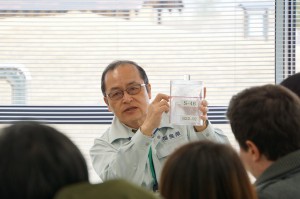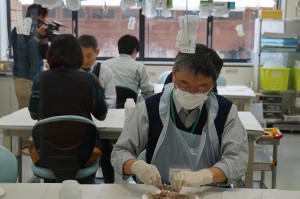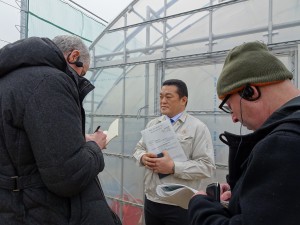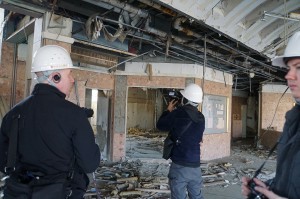実施日 : 2017年03月06日(月) - 07日(火)
Report: Fukushima / Miyagi Press Tour, 6 Years After the Disaster
投稿日 : 2017年04月03日
Just before the six-year anniversary of the Great East Japan Earthquake,the FPCJ held a press tour to the prefectures of Fukushima and Miyagi. The tour covered three themes:
1) Food, tourism, and renewable energy: Fukushima’s challenge
2) Passing on the lessons of the disaster: Disaster-prevention tourism in Minamisanriku
3) Aiming for sustainable development amidst population decline: Rebuilding Onagawa.
A total of 13 journalists participated in the tour, from France, Russia, Singapore, South Korea, Switzerland, Taiwan, and the UAE.
Click here for further details on the tour
Click here for a log of real-time Twitter updates from during the tour
Fukushima Agricultural Technology Centre
 The tour started with an explanation from Mr. Kenji Kusano, vice manager of the Fukushima Agricultural Technology Centre’s Agricultural Safety Promotion Department, Instruction & Certification of Organic Agricultural Products Division about the radiation monitoring tests carried out at the centre. This was followed by a few cameramen and journalists acting as representatives for pool coverage in the testing and preparation rooms, to which access is limited. The process of preparing a sample and testing it with a germanium semiconductor detector was filmed, while the rest of the journalists listened to an explanation from Mr. Kusano and observed from outside the room. The journalists asked a number of questions, including the cost of analyzing agricultural and marine products, the methods and rules for selecting samples, the reaction of overseas markets, and how long the testing will continue. Mr. Kusano said, “Fukushima has a strong conviction to only send out safe agricultural and marine products that have passed testing, so we will continue testing until consumers are no longer concerned.”
The tour started with an explanation from Mr. Kenji Kusano, vice manager of the Fukushima Agricultural Technology Centre’s Agricultural Safety Promotion Department, Instruction & Certification of Organic Agricultural Products Division about the radiation monitoring tests carried out at the centre. This was followed by a few cameramen and journalists acting as representatives for pool coverage in the testing and preparation rooms, to which access is limited. The process of preparing a sample and testing it with a germanium semiconductor detector was filmed, while the rest of the journalists listened to an explanation from Mr. Kusano and observed from outside the room. The journalists asked a number of questions, including the cost of analyzing agricultural and marine products, the methods and rules for selecting samples, the reaction of overseas markets, and how long the testing will continue. Mr. Kusano said, “Fukushima has a strong conviction to only send out safe agricultural and marine products that have passed testing, so we will continue testing until consumers are no longer concerned.”


Couple Who Resumed Farming After Evacuating to Fukushima City from Iitate
 Next, the group visited Mr. and Ms. Shigihara, a couple that evacuated to Fukushima City from the Nagadoro district of Iitate, where they once again began cultivating asparagus. The journalists were told about the path the couple took towards resuming farming, their current situation, how the asparagus harvest was, the couple’s opinion on the monitoring of agricultural products being carried out at the Fukushima Agricultural Technology Centre, life after evacuating due to the nuclear accident, the condition of their home in Iitate, and subsidies and support for resuming agriculture. Mr. Makoto Sugioka of the Iitate Village Office Recovery Section, explained the support provided by the village government. One question the journalists asked was “How many farmers that evacuate from Iitate have resumed farming, and what areas do they live in?”
Next, the group visited Mr. and Ms. Shigihara, a couple that evacuated to Fukushima City from the Nagadoro district of Iitate, where they once again began cultivating asparagus. The journalists were told about the path the couple took towards resuming farming, their current situation, how the asparagus harvest was, the couple’s opinion on the monitoring of agricultural products being carried out at the Fukushima Agricultural Technology Centre, life after evacuating due to the nuclear accident, the condition of their home in Iitate, and subsidies and support for resuming agriculture. Mr. Makoto Sugioka of the Iitate Village Office Recovery Section, explained the support provided by the village government. One question the journalists asked was “How many farmers that evacuate from Iitate have resumed farming, and what areas do they live in?”


Tsuchiyu Onsen
The number of tourists visiting Tsuchiyu Onsen has decreased since the nuclear accident. Mr. Katsuichi Kato, chairman of the Tsuchiyu Onsen Town Recovery Council and president of local power company Genki Up Tsuchiyu, spoke about the tourism resources of Tsuchiyu Onsen, what things were like after the Great East Japan Earthquake, the impact of the disaster on the tourism industry, and how reconstruction had progressed after six years. Next, he showed the group power generation facilities using the hot springs heat, and fish farms making use of waste heat. The journalists asked about sales of the electricity generated, the reason for selling electricity, and plans for expanding generation facilities. The group then split into two, filming and photographing the townscape of Tsuchiyu Onsen or the bathing facilities, experiencing the onsen, and interviewing the operator of an inn that took in evacuees after the Great East Japan Earthquake.


Minami Sanriku Hotel Kanyo, Interview with Manager
The group traveled from Fukushima City, Fukushima to Minamisanriku, Miyagi, where they visited the Minami Sanriku Hotel Kanyo, which took in people who had evacuated from their homes after the earthquake. After supper, the journalists interviewed Ms. Noriko Abe, the hotel manager. She spoke about how the hotel took in and supported evacuees even when the water and power were cut off, efforts made to make them feel welcome, and why the hotel decided to organize a bus tour in which “storytellers” passed on the lessons learned from the disaster. The journalists listened intently to Ms. Abe, and more than one TV station carried out individual interviews.


【Day 2】
Minami Sanriku Hotel Kanyo, Disaster-Prevention Tourism
 The second day of the press tour began with the “storyteller bus tour” that the hotel started running in February 2012. With hotel employee Mr. Ito as a guide, the group went around Minamisanriku, where work is proceeding on raising the ground level, and visited buildings owned by the hotel that have been preserved to pass on the lessons of the disaster. The journalists filmed and photographed the aftermath of buildings that had been hit by a 20-meter-tall tsunami. Mr. Ito explained what it was like during the disaster, including his own personal experiences, and said, “I believe that passing on the experiences and lessons learned from the disaster will help save future lives.”
The second day of the press tour began with the “storyteller bus tour” that the hotel started running in February 2012. With hotel employee Mr. Ito as a guide, the group went around Minamisanriku, where work is proceeding on raising the ground level, and visited buildings owned by the hotel that have been preserved to pass on the lessons of the disaster. The journalists filmed and photographed the aftermath of buildings that had been hit by a 20-meter-tall tsunami. Mr. Ito explained what it was like during the disaster, including his own personal experiences, and said, “I believe that passing on the experiences and lessons learned from the disaster will help save future lives.”


Onagawa (JR Onagawa Station, Onagawa Onsen Yupoppo)
The tour visited Onagawa, a town that started rebuilding from scratch after the disaster which has been called a frontrunner of the reconstruction. With the JR Onagawa Station having been rebuilt in 2015, vitality has begun to return to the town. First, the group heard from Onagawa town officials about how Onagawa set a shorter goal than average for reconstruction, eight years, in order to avoid people leaving the town due to the disaster through a speedy reconstruction. The official said, “The goal of the reconstruction is for residents who returned to live in Onagawa and those who have supported the reconstruction to feel glad they did so.” The group then visited the hot springs facility and souvenir stores built alongside JR Onagawa Station, and the new tenant commercial facility Sea Pearl Pier Onagawa.


Sea Pearl Pier Onagawa: Sessionable Co. (Guitar Manufacturing & Sales)
Sessionable Co. is a guitar manufacturing and sales company established three years ago in Onagawa, with its workshop located in Sea Pearl Pier Onagawa, where the journalists interviewed company president Mr. Yosuku Kajiya. Questions included, “Why did you decide to start your business in Onagawa,” and “Will you continue manufacturing products in Onagawa in the future?” There was also an opportunity to film and photograph the process of manufacturing the “Made in Onagawa” guitars that had their first shipment sent out at the end of March, and Mr. Kajiya playing guitar.


Sea Pearl Pier Onagawa: NPO Minato-machi Ceramika Kobo (Tile Making)
Next, the tour visited Minato-machi Ceramika Kobo, an NPO that manufactures and sells tiles in the shopping center, and decorates Onagawa with colorful Spanish tiles. The journalists interviewed president Ms. Narumi Abe about why she started the workshop, how business was, and what kind of people worked there. The group then filmed and photographed a nearby corner in town decorated with tiles made by visitors to Onagawa.


Post-Disaster Public Housing, Resident Interviews
The group then went to post-disaster public housing run by the municipal government, and at the café there interviewed seven residents including Mr. Hiroshi Suzuki, representative of the Oharakita district, about life in the public housing and initiatives by residents to encourage building a community. The journalists listened closely as the residents explained what happened to them during the disaster, the state of reconstruction for local industries, and social events held in the public housing facility.


Interview with the Mayor of Suda
 The final stop on this press tour was the Onagawa Town Office, where Mr. Yoshiaki Suda, mayor of Onagawa, gave an interview. Questions included, “(Mentioning an earlier interviewee, Mr. Kajiya from Sessionable Co., having moved to Onagawa) What is it about Onagawa that makes people from elsewhere want to live and start businesses here,” and “What is the biggest change comparing before and after the disaster?” Mayor Suda said, “New values can create diverse possibilities and connections between people. Together with residents in and around the town, I would like to restart and develop a sustainable town.”
The final stop on this press tour was the Onagawa Town Office, where Mr. Yoshiaki Suda, mayor of Onagawa, gave an interview. Questions included, “(Mentioning an earlier interviewee, Mr. Kajiya from Sessionable Co., having moved to Onagawa) What is it about Onagawa that makes people from elsewhere want to live and start businesses here,” and “What is the biggest change comparing before and after the disaster?” Mayor Suda said, “New values can create diverse possibilities and connections between people. Together with residents in and around the town, I would like to restart and develop a sustainable town.”





